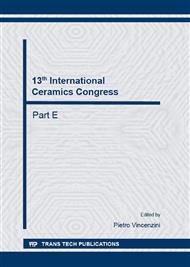p.82
p.88
p.94
p.100
p.108
p.117
p.123
p.134
p.140
Comparison of the Ablation Mechanism of C/C-SiC Composite under Atmospheric and Low Pressure
Abstract:
Comparisons of heating tests at atmospheric pressure and low pressure by using a thermal plasma torch were performed. A constant heat flux on the sample surface was applied in the study of the oxidation mechanism of C/C-SiC composite, used in thermal protection systems. The SEM and EDS analysis show an intensive glassification at the surface, which are strongly depend on the oxygen partial pressure and the sample surface temperature. For vacuum conditions, at maximum surface temperature of 1450 °C and the oxygen partial pressure of about 66 Pa, a uniform passivation layer of SiO2 is formed. At atmospheric pressure, under an oxygen partial pressure of 2.1×104 Pa, the maximum surface temperature is 400 °C higher than obtained in vacuum, reaching levels of 1850°C. Under these conditions, the protective oxide layer is partially volatilized with time, increasing the specific mass loss rate by a sublimation of the composite, directly exposed to the plasma jet. This effect is alike to what occurs in the process of transition from passive to active oxidation of SiC.
Info:
Periodical:
Pages:
134-139
Citation:
Online since:
October 2014
Price:
Сopyright:
© 2014 Trans Tech Publications Ltd. All Rights Reserved
Share:
Citation:


